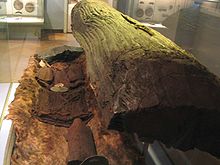Tree coffin



A tree coffin or tree of the dead ( Danish Bulkiste ) is a coffin made from a tree trunk that has been split lengthways and hollowed out. When using oak wood , the tannin contained in the wood often led to a good preservation of organic materials, especially textiles . Often, however, only discolouration in the ground indicates burials in tree coffins.
Tree coffins were primarily in the Nordic Bronze Age in mounds deposited, but come to the Middle Ages before. Some early Bronze Age barrows in Jutland ( Denmark ) hold a special position in archaeological research. The large barrows at Borum Eshøj , Guldhøj, Muldbjerg, Skrydstrup and Trindhøj were usually built from peat , which formed a massive, damp blanket over the graves. Iron salts, which occur naturally in peat, created a layer of iron sandstone . The layer prevented air from entering the interior of the hill. The oak coffins and their contents were enclosed in a protective environment very similar to that of moors . The degree of preservation of the skeletons varies from hill to hill.
The best known tree coffin burial is the girl from Egtved . Muldbjerg's grave also contained textiles in good condition. The hair is often well preserved. Sometimes facial features can even be seen. The well-preserved skin of the young woman from Skrydstrup reveals beautiful features. She wears a hairstyle with a network of black horse hair. There were gold rings next to her ears. From the man's grave in Guldhøj, fur from the otter and some wooden objects were recovered, including bowls and a wooden folding chair. In the belt was a dagger in a wooden sheath. As in most of the other graves, the body lay on a cow hide. The men from Muldbjerg and Trindhøj provided information about clothing and jewelry: both were dressed in long loincloths that were held in place with leather straps. There weren't any pants yet. Both men wore a kidney-shaped cloak over their shoulder and a round cap. Swords, clasps, double buttons and belt ornaments completed their equipment.
A total of about 60 tree coffins are known from Denmark and Schleswig. As far as they can be dendrochronologically dated (28 specimens), they come mainly from the period between 1391 and 1344 BC. Only three of them are more recent. In the hill of Eldsberga (Sweden) two tree coffins were on the roof of a passage grave deposited and a Röse covers, which was ultimately covered by a mound.
Tree coffins were also used during the Migration Period and the Viking Age . They can be found in Switzerland, for example, in the city of Bülach , in the Bern Minster , in the Merovingian Chapel of Sankt Stephan in the Biel-Mett district (7th century) and in the area of the municipality of Zillis-Reischen (8th century). A tree coffin from the late 8th century is in the collegiate church in Mattsee . Tree coffins were also found in South Tyrol near the Sankt Zeno church near Reifenstein Castle . A number of tree coffins from the Franconian - Alemannic burial ground of Oberflacht near Tuttlingen (Baden-Württemberg) from the 6th century are particularly well preserved ; there are images of snakes or dragons carved into the lids. In addition to the Magdeburg Cathedral in Saxony-Anhalt (possibly the location of a royal palace ), numerous graves, including tree coffins, were found.
From France, only one find with a head recess in the tree trunk in the cemetery of the Sainte-Foy priory in Coulommiers ( Seine-et-Marne department ) is known. In the Netherlands there are finds from the 6th to 10th centuries on the Walcheren peninsula (Zealand). In the UK were in Selby (county North Yorkshire ) on the Church Hill 14 oak tree coffins, where once stood the church, found. Another site is on Edinburgh Castle Hill ( Scotland ). In the city of Skara (Sweden) in 1889, four tree coffins were discovered just outside the cathedral during sewer work. 72 west-east facing tree coffins were found in Wernigerode am Harz . The research results on Franconian tree coffin burials from Wesel / Bislich , where around 800 tree coffins are located, Eick (City of Moers), Junkersdorf near Cologne and Hohenfels (Daun) are only partially published.
literature
- Ingrid Falktoft Anderson: Vejviser til Danmarks oldtid . 1994, ISBN 87-89531-10-8 , pp. 96-97
- Adolf Cassau: To the tree coffin find from Beckdorf, Kr. Stade. In: News from Lower Saxony's prehistory. 10, 1936, pp. 41-48.
- Adolf Cassau: Three Bronze Age grave finds in the districts of Stade and Bremervörde. In: News from Lower Saxony's prehistory. 7, 1933, pp. 39-58.
- Karsten Kjer Michaelsen: Politics bog om Danmarks oldtid . Copenhagen 2002 ISBN 87-567-6458-8 , pp. 100, 103.
- K. Randsborg, K. Christensen: Bronze Age Oak-Coffin Graves. Acta Archaeologica 77, 2006.
- K. Zimmermann: Tree coffin and dead tree: To a burial under the Bern Minster. Acta Bernensia, 1992.
Web links
- Wilfried Menghin: Oberflacht: Between Valhalla and Paradise. Article about tree coffins from Oberflacht in Baden-Württemberg, online at DHM.de, accessed on January 7, 2017.
- Gristhorpe Man: a Bronze Age warrior chieftain? In: Archaeo News. Online at Stonepages.com, accessed January 7, 2017.
Individual evidence
- ↑ Bronze Age Oak-Coffin Graves. ( Page no longer available , search in web archives ) Info: The link was automatically marked as defective. Please check the link according to the instructions and then remove this notice. In: Archaeologica. Volume 77, Issue 1, December 2006, John Wiley & Sons, p. 187, online at OnlineLibrary.Wiley.com, accessed January 7, 2017.